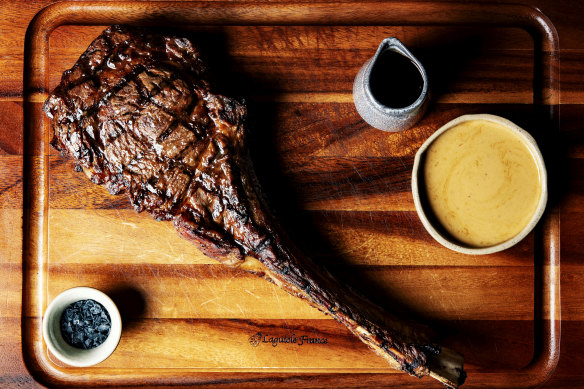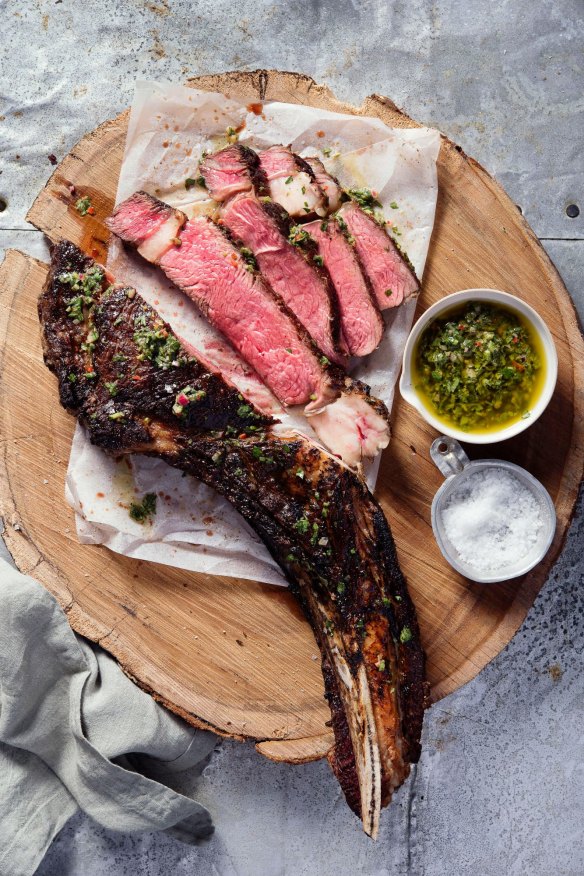$361 for a steak? Top butcher says the tomahawk is ‘a bit overrated’
If you’re going to splash your cash like the Seven Network allegedly did with Bruce Lehrmann, you can do better than the axe-shaped steak favoured for its showpiece-worthy size. Here’s what to order instead.
Tomahawk steaks hit the news cycle this week, with unproven claims that Bruce Lehrmann had one weighing a whopping 1.9 kilos – and costing a whopping $361 – courtesy of the Seven Network. So, Good Food asked butcher Troy Wheeler, who owns Melbourne’s Meatsmith butcher shops alongside chef Andrew McConnell, for a tomahawk 101. We wanted to know: if you’re going to splash cash on fancy meat, is this the cut to order?

What exactly is it?
“A true tomahawk is a beef rib-eye [or scotch fillet] on the bone, with the full length of the rib bone … that goes right to the end of the brisket cartilage,” Wheeler says. It’s a huge steak, usually between 30 and 40 centimetres in length, and two to 2.2 kilograms in weight. Sometimes the short-rib meat is left on the bone, other times it’s scraped clean.
What’s the allure?
It’s unsurprising that a steak named after an axe (because it resembles one) is favoured for its showpiece-worthy size and servability. “I reckon it’s all about the theatre, the grandeur of a massive bit of steak that’s carved up and [becomes] the centrepiece of the table,” Wheeler says. “I think [it’s] a bit overrated.” But why?
It’s expensive – and you’re paying for the bone
A tomahawk is one of the more exxy cuts you see at restaurants and butcher shops. Because a rib-eye is expensive in itself, when there’s a long bone added, and you’re paying by weight, it jacks up the price. “I don’t think people realise that,” Wheeler says. “I have this conversation with customers a lot.” Meatsmith charges around $55 a kilo for a tomahawk, which means they’re $150-odd apiece. It can be double or even pushing triple that in restaurants for a steak you can’t even eat in its entirety.

Cooking it well is no mean feat
A fair bit of care and consideration is needed to nail the cooking of a tomahawk at home, particularly if short rib is involved. “On one side of the bone is a rib-eye you want to have medium or medium-rare, with a shorter cooking time … like 20 minutes. The other end is essentially short rib that’s best cooked or smoked slowly and longer,” Wheeler says.
“A lot of people do the reverse sear: cook at a low temp – maybe 48 degrees – for a few hours then seal it off to give it a crust all over. If it’s your first time cooking one, if you’re just looking for novelty, it’d be pretty easy to stuff it up.”
Wheeler adds: “It seems to be a fairly blokey thing. The guys get on the barbecue with this humungous piece of meat.”
So, leave it to the experts, rookie cooks
If you’re hell-bent on eating a tomahawk – but you’re not a confident cook – your best bet is to order it at a restaurant or steakhouse you know will prepare it to perfection.
But there are better bang-for-your-buck cuts
“A slightly more economical alternative is the T-bone,” says Wheeler. He recommends thick-cut, channelling the famous Tuscan steak dish bistecca alla Fiorentina. Slicing up a sizeable T-bone – between 1.2 and 1.5 kilos – is similar to the tomahawk experience.
So, is a tomahawk worth it?
“I’d rather just have the two individual cuts on their own,” says Wheeler, preferring to scrap the tomahawk theatrics in favour of taking the rib-eye and short rib separately. They’re better value, easier to cook, and you don’t have to contend with the bone.
The best recipes from Australia's leading chefs straight to your inbox.
Sign up